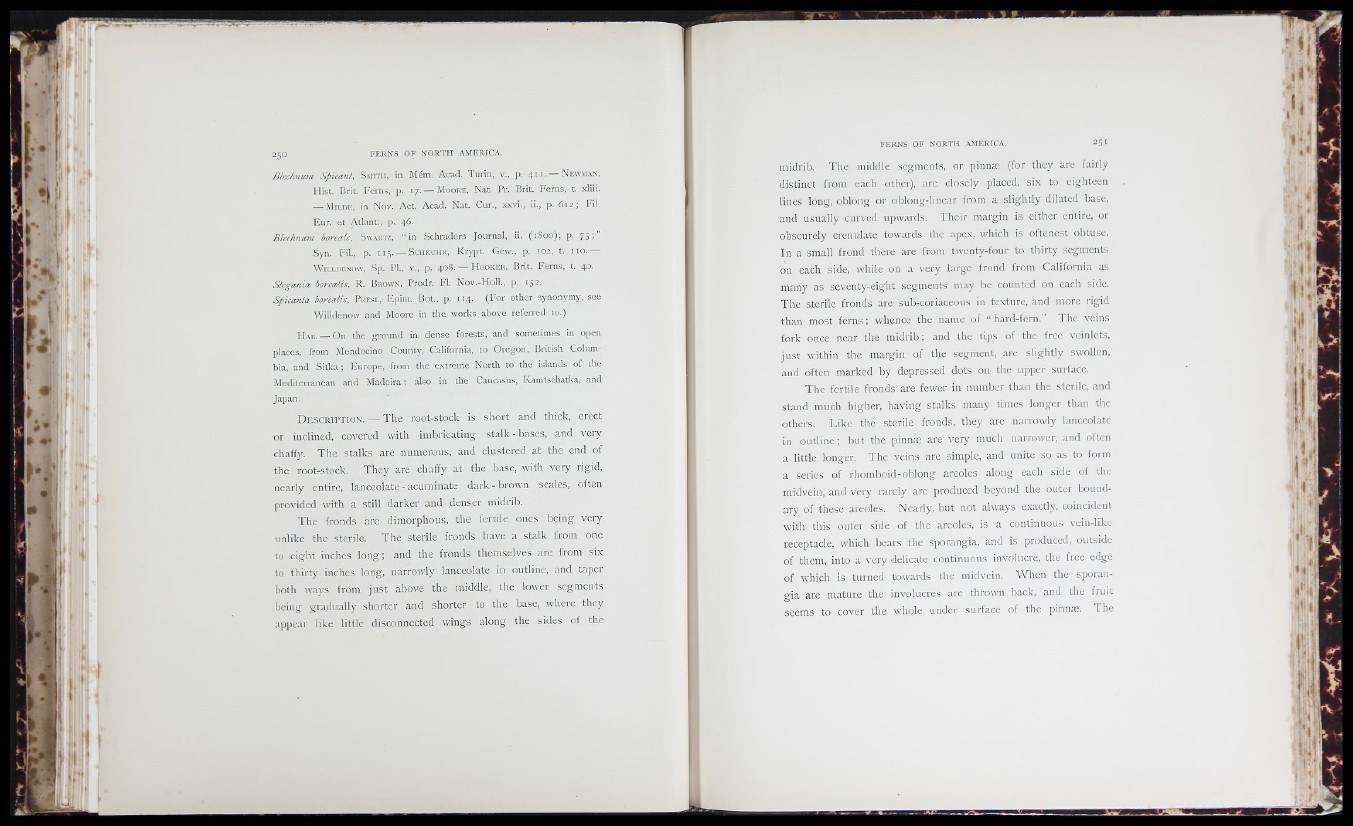
' ; ;G‘
. ■ • ’ f
¡ ''
V «
>•
ft !V)
i !
PirG
* - i . *
r
• J '
r t :
2 5 0 FE RN S OF N O R TH AMERICA.
Blecknum Spicant, Sm ith , in Mem. Acad. Turin, v ., p. 4 1 1. — Newm an ,
Hist. Brit. Ferns, p . 17. — M o o r e , Nat. Pr. Brit. Ferns, t. xliii.
— M i ld e , in Nov. Act. Acad. Nat. Cur., xxvi., ii., p . 6 1 2 ; Fil.
Eur. ct Atlant., p . 4 6.
Blechnum boreeile, S w a r t z , “ in Schraders Journal, ii. (1800), p. 7 5 ; ”
Syn. Fil., p. 115 . — SctiKUHK, Krypt. Gew., p. 102, t. n o .—
W il l d e n o w , Sp. Pi., v „ p. 408.— H o o k e r . Brit. Ferns, t. 40.
Slegama. borealis, R. B r o w n , Prodr. Fi. Nov.-Holi., p . 152.
Spicanta borealis, P e e s i , Epim. Bot., p. 1 14. (For otiter synonymy, see
Willdenow and Moore in the works above referred to.)
p lA B ,_O n the ground in dense forests, and sometimes in open
places, from Mendocino County, California, to Oregon, British Columbia,
and Sitka ; Europe, from the extreme North to the islands of the
Mediterranean and Madeira; also in the Caucasus, Kamtschatka, and
Japan.
D e s c r i p t i o n . — The root-stock is short and thick, erect
or inclined, covered with imbricating stalk - bases, and very
chaffy. The stalks are numerous, and clustered at the end of
the root-stock. They are chaffy at the base, with very rigid,
nearly entire, lanceolate - acuminate dark-brown scales, often
provided with a still darker and denser midrib.
The fronds are dimorphous, the fertile ones being very
unlike the sterile. The sterile fronds have a stalk from one
to eight inches long; and the fronds themselves are from six
to thirty inches long, narrowly lanceolate in outline, and taper
both ways from just above the middle, the lower segments
being gradually shorter and shorter to the base, where they
appear like little disconnected wings along the sides of the
• ' b
t *
I I
FERNS OF NORTH AMERICA. 251
midrib. The middle segments, or pinnæ (for they are fairly
distinct from each other), are closely placed, six to eighteen
lines long, oblong or oblong-linear from a slightly dilated base,
and usually curved upwards. Their margin is either entire, or
obscurely crenulate towards the apex, which is oftenest obtuse.
In a small frond there are from twenty-four to thirty segments
on each side, while on a very large frond from California as
many as seventy-eight segments may be counted on each side.
The sterile fronds are sub-coriaceous in texture, and more rigid
than most ferns; whence the name of “ hard-fern.” The veins
fork once near the midrib; and the tips of the free veinlets,
just within the margin of the segment, arc slightly swollen,
and often marked by depressed dots on the upper surface.
The fertile fronds arc fewer in number than the sterile, and
stand much higher, having stalks many times longer than the
others. Like the sterile fronds, they arc narrowly lanceolate
in outline; but the pinnæ are very much narrower, and often
a little longer. The veins are simple, and unite so as to form
a series of rhomboid-oblong areoles along each side of the
midvein, and very rarely are produced beyond the outer boundary
of these areoles. Nearly, but not always exactly, coincident
with this outer side of the areoles, is a continuous vein-likc
receptacle, which bears the sporangia, and is produced, outside
of them, into a very delicate continuous involucre, the free edge
of which is turned towards the midvein. When the sporangia
are mature the involucres are thrown back, and the fruit
seems to cover the whole under surface of the pinnæ. The
il'
I
J
H *!
Iü '
.1 i
'"’ I !?